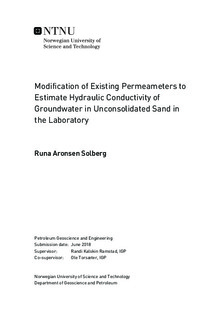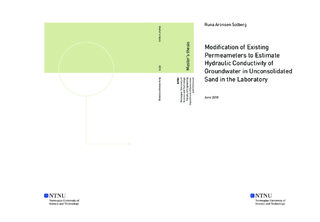| dc.description.abstract | Modification of Existing Permeameters to Estimate Hydraulic Conductivity of Groundwater in Unconsolidated Sand in the Laboratory is a master thesis written by Runa Aronsen Solberg in the spring of 2018. The thesis is the final work of the course TPG4920 Petroleum Engineering, Master s Thesis, at the Department of Geoscience and Petroleum at the Norwegian University of Science and Technology (NTNU). The thesis is a continuation of the author s specialization project completed during autumn 2017. The thesis contains a total of 116 pages.
Hydraulic conductivity describes how easily a fluid is transported through a porous medium and can be estimated using several methods. A simple and cost-efficient method used to estimate hydraulic conductivity is by permeameter testing in the laboratory. It has proved to be a challenge to estimate hydraulic conductivity in the laboratory because the sample material does not represent an undisturbed "in situ" material in the field, because the grain structure of the sample is disturbed during the drilling process of groundwater wells and when transported from the well to the laboratory. The objective of this thesis is to modify 3 already existing permeameters; the Darcy-cell, the air permeameter and the liquid permeameter (the latter 2 collectively called core permeameters), to better calculate the hydraulic conductivity of groundwater in unconsolidated sand in the laboratory. The purpose of this is to obtain results for hydraulic conductivity of groundwater that can be used as an estimate of the in-situ hydraulic conductivity in unconsolidated sand in the field.
The smallest average value of hydraulic conductivity is estimated using the liquid permeameter with a value of 2,19×〖10〗^(-6) m/s, followed by the air permeameter with a value of 2,25×〖10〗^(-5) m/s. The largest value was estimated using the Darcy -cell with an average of 1,26×〖10〗^(-3) m/s. The results show that it is not possible to use the modified core permeameters to estimate the hydraulic conductivity of groundwater in unconsolidated sand. Further modifications of the setup and collection of more data is needed. The modified Darcy-cell provides the most reliable values for hydraulic conductivity, but methods of fully saturating the sample needs to be further investigated to obtain results for hydraulic conductivity of groundwater that can be used as an estimate of the in-situ hydraulic conductivity of unconsolidated sand in the field. | |

